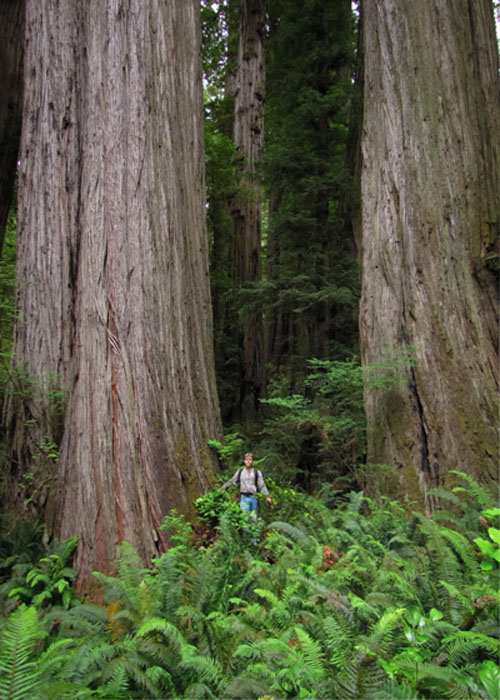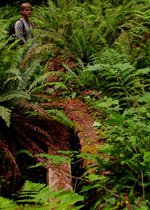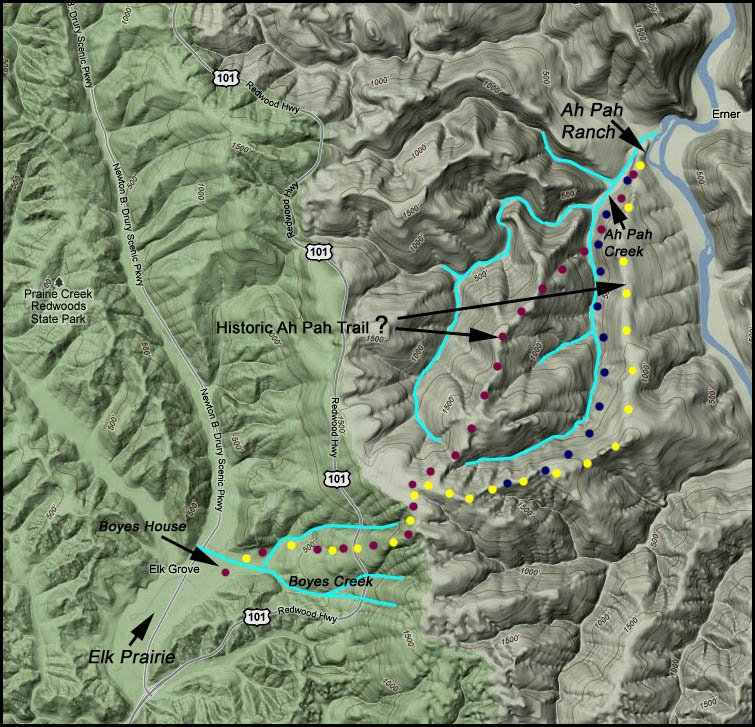
Historic Ah Pah Trail
Boyes' Prairie, aka "Elk Prairie"
by Mario Vaden

advertisement
Historical Ah Pah Trail

Hidden somewhere in Prairie Creek Redwoods State Park are a few remnants of a historic 6 to 7 mile Ah Pah trail that went NE through the forest and hills to Ah Pah Creek at the Klamath River. It is not the 0.3 mile Ah Pah Interpretive trail at the north end of the park.
The historic trail started near the Boyes' Prairie at the NE end of the Elk Prairie. The Elk Prairie is the same as Boyes' Prairie. The historic Boyes building and remnants of an orchard are still there. Opposite Drury Parkway from the visitor center.
From the NE end of the prairie, that trail followed a path from near Boyes Creek, finally ending at an Ah Pah Ranch belonging to C. W. Ward. Latitude: 41.4192889 Longitude: -123.9417368
Image: Michael Taylor near Boyes Creek
The Ah Pah Ranch area was a sportsman's "mecca" in those days. In 1882, a trail was opened from the Boyes' Prairie NE to Ah Pah Ranch. It began at the Boyes' place, where horses could be rented for the short travel through the hills. This Ah Pah trail was a branch of the Trinidad-Klamath trail which also passed by Tall Trees Grove by Redwood Creek.
Across the Klamath from Ah Pah Ranch was Erner, a former Yurok settlement near the Blue Creek.
In 2010, Michael Taylor and I found a few fragments of an old abandoned trail between Boyes Creek and its northern tributary. If the original Ah Pah Trail was also on the ridge between the two main Ah Pah Creek forks to the NE, the trail remnant we found could be in the perfect place for the shortest distance between two places. Historically, some native American Indian trails in the area followed ridges. And that may have been practical for the Ah Pah Trail too.

In the map below, I marked a few suggested locations for the trail. The purple dots seems like the most practical. Since it was only 6 to 7 miles, there may not have been a need to cut the trail down near water. Its easy to carry water for such a short travel. Presently, on satellite images, you can see old roads from past logging along the same ridge tops. Those would have erased virtually any remants of the Ah Pah Trail if it was in the same place.
My exploring in the redwoods leads me to believe that the practice of trails on ridges would have been ideal for the Ah Pah Trail too. But a question came to mind about water for horses if the trail was not down near creeks. Several people I"ve talked to who train and ride horses, said that 6 to 7 miles in that cool climate would be fine for horses if they were on a trail up away from a creek.
A 1983 - 1884 government document regarding the Hy. 101 bypass proposed in the area included:
"Limited historical research has not suggested the presence of any significant listorical remains in the proposed bypass area. Only signs of early lumbering lctivity, such as logging roads, springboard marks, and artifactual material in the form of old saws or cables may be expected as brush-clearing progresses.
The Ah Pah Trail route is undoubtedly overgrown and possibly significantly alltered by later lumbering operations. However, it is possible that remnantsof the trail are still recognizable."
"The Ah Pah Trail is known to have been located in the path of the bypass route. The Ah Pah Trail was a branch of the Trinidad-Klamath Trail that was opened about 1882 and trended northeast from Prairie Creek toward the Klamath River."
The present day Ah Pah Trail is a short hike several miles north of the visitor center and prairie. For more about this more recently built trail, visit redwoodhikes.com
Some information from:
REDWOOD NATIONAL PARK, History Basic Data, Del Norte and Humboldt Counties, California
U.S. Department of the Interior, National Park Service, Division of History, Office of Archeology and Historic Preservation
Edwin C. Bearss, National Park Service historian
September 1, 1969 / Reprinted March 1982
